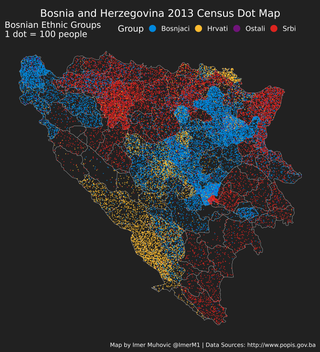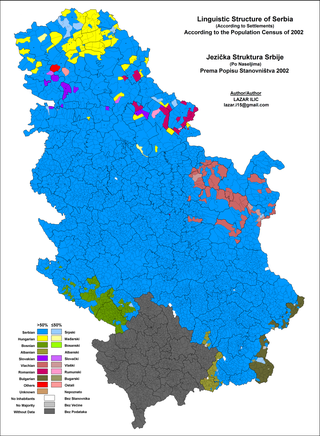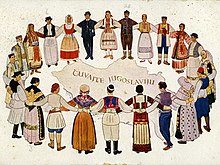
Yugoslavia was a country in Southeast and Central Europe that existed from 1918 to 1992.

The Kingdom of Yugoslavia was a country in Southeast and Central Europe that existed from 1918 until 1941. From 1918 to 1929, it was officially called the Kingdom of Serbs, Croats, and Slovenes, but the term "Yugoslavia" was its colloquial name due to its origins. The official name of the state was changed to "Kingdom of Yugoslavia" by King Alexander I on 3 October 1929.

More than 96% of population of Bosnia and Herzegovina belongs to one of its three autochthonous constituent peoples : Bosniaks, Serbs and Croats. The term constituent refers to the fact that these three ethnic groups are explicitly mentioned in the constitution, and that none of them can be considered a minority or immigrant. The most easily recognisable feature that distinguishes the three ethnic groups is their religion, with Bosniaks predominantly Muslim, Serbs predominantly Eastern Orthodox, and Croats Catholic.

"Muslims" is a designation for the ethnoreligious group of Serbo-Croatian-speaking Muslims and people of Muslim heritage, inhabiting mostly the territory of the former Socialist Federal Republic of Yugoslavia. The term, adopted in the 1971 Constitution of Yugoslavia, groups together a number of distinct South Slavic communities of Islamic ethnocultural tradition. Prior to 1993, a vast majority of present-day Bosniaks self-identified as ethnic Muslims, along with some smaller groups of different ethnicity, such as Gorani and Torbeši. This designation did not include Yugoslav non-Slavic Muslims, such as Turks, some Romani people and majority of Albanians.

Yugoslavs or Yugoslavians is an identity that was originally designed to refer to a united South Slavic people. It has been used in two connotations: the first in a sense of common shared ethnic descent, i.e. panethnic or supraethnic connotation for ethnic South Slavs, and the second as a term for all citizens of former Yugoslavia regardless of ethnicity. Cultural and political advocates of Yugoslav identity have historically ascribed the identity to be applicable to all people of South Slav heritage, including those of modern Bosnia and Herzegovina, Croatia, Montenegro, North Macedonia, Serbia, and Slovenia. Although Bulgarians are a South Slavic group, attempts at uniting Bulgaria into Yugoslavia were unsuccessful, and therefore Bulgarians were not included in the panethnic identification. Since the dissolution of Yugoslavia and the establishment of South Slavic nation states, the term ethnic Yugoslavs has been used to refer to those who exclusively view themselves as Yugoslavs with no other ethnic self-identification, many of these being of mixed ancestry.

The Yugoslav Partisans, or the National Liberation Army, officially the National Liberation Army and Partisan Detachments of Yugoslavia, was the communist-led anti-fascist resistance to the Axis powers in occupied Yugoslavia during World War II. Led by Josip Broz Tito, the Partisans are considered to be Europe's most effective anti-Axis resistance movement during World War II.

Demographics of the Socialist Federal Republic of Yugoslavia, during its existence from 1945 until 1991, include population density, ethnicity, education level, health of the populace, economic status, religious affiliations and other aspects. During its last census in 1991, Yugoslavia enumerated 23,528,230 people. Serbs had a plurality, followed by Croats, Bosniaks, Albanians, Slovenes and Macedonians.

After a period of political and economic crisis in the 1980s, constituent republics of the Socialist Federal Republic of Yugoslavia split apart, but the unresolved issues caused a series of inter-ethnic Yugoslav Wars. The wars primarily affected Bosnia and Herzegovina, neighbouring parts of Croatia and, some years later, Kosovo.

Brotherhood and unity was a popular slogan of the League of Communists of Yugoslavia that was coined during the Yugoslav People's Liberation War (1941–45), and which evolved into a guiding principle of Yugoslavia's post-war inter-ethnic policy. In Slovenia, the slogan "Brotherhood and Peace" was used in the beginning.

The Socialist Republic of Bosnia and Herzegovina, commonly referred to as Socialist Bosnia or simply Bosnia, was one of the six constituent federal states forming the Socialist Federal Republic of Yugoslavia. It was a predecessor of the modern-day Bosnia and Herzegovina, existing between 1945 and 1992, under a number of different formal names, including Democratic Bosnia and Herzegovina (1943–1946) and People's Republic of Bosnia and Herzegovina (1946–1963).
Languages of Yugoslavia are all languages spoken in former Yugoslavia. They are mainly Indo-European languages and dialects, namely dominant South Slavic varieties as well as Albanian, Aromanian, Czech, German, Italian, Venetian, Balkan Romani, Romanian, Pannonian Rusyn, Slovak and Ukrainian languages. There are also pockets where varieties of non-Indo-European languages, such as those of Hungarian and Turkish, are spoken.

Serbia has only one nationwide official language, which is Serbian. The largest other languages spoken in Serbia include Hungarian, Bosnian and Croatian. The Autonomous Province of Vojvodina has 6 official languages: Serbian, Hungarian, Slovak, Romanian, Croatian, Rusyn; whilst Autonomous Province of Kosovo and Metohija, which Serbia claims as its own, has two: Albanian and Serbian.

Yugoslavia was a state concept among the South Slavic intelligentsia and later popular masses from the 19th to early 20th centuries that culminated in its realization after the 1918 collapse of Austria-Hungary at the end of World War I and the formation of the Kingdom of Serbs, Croats and Slovenes. However, the kingdom was better known colloquially as Yugoslavia ; in 1929 it was formally renamed the "Kingdom of Yugoslavia".

Bosniak nationalism or Bosniakdom is the nationalism that asserts the nationality of Bosniaks and promotes the cultural unity of the Bosniaks. It should not be confused with Bosnian nationalism, often referred to as Bosniandom, as Bosniaks are treated as a constituent people by the preamble of Constitution of Bosnia and Herzegovina, whereas people who identify as Bosnians for nationality are not. Bosniaks were formerly called Muslims in census data but this model was last used in the 1991 census.

Serbs are, by large, first or second generation immigrants from other republics of former Yugoslavia. In the 2002 census, 38,964 people of Slovenia declared Serb ethnicity, corresponding to 2% of the total population, making them the largest ethnic minority in the country.

Yugoslavism, Yugoslavdom, or Yugoslav nationalism is an ideology supporting the notion that the South Slavs, namely the Bosniaks, Croats, Macedonians, Montenegrins, Serbs and Slovenes, but also Bulgarians, belong to a single Yugoslav nation separated by diverging historical circumstances, forms of speech, and religious divides. During the interwar period, Yugoslavism became predominant in, and then the official ideology of the Kingdom of Yugoslavia. There were two major forms of Yugoslavism in the period: the regime favoured integral Yugoslavism promoting unitarism, centralisation, and unification of the country's ethnic groups into a single Yugoslav nation, by coercion if necessary. The approach was also applied to languages spoken in the Kingdom. The main alternative was federalist Yugoslavism which advocated the autonomy of the historical lands in the form of a federation and gradual unification without outside pressure. Both agreed on the concept of National Oneness developed as an expression of the strategic alliance of South Slavs in Austria-Hungary in the early 20th century. The concept was meant as a notion that the South Slavs belong to a single "race", were of "one blood", and had shared language. It was considered neutral regarding the choice of centralism or federalism.
There are several points of dispute over the ethnic and linguistic identity of several communities in Montenegro, some of them related to identity of people who self-identify as ethnic Montenegrins, while some other identity issues are also related to communities of Serbs, Croats, Bosniaks and ethnic Muslims. All of those issues are mutually interconnected and highly politicized.

Montenegrin nationalism is the nationalism that asserts that Montenegrins are a nation and promotes the cultural unity of Montenegrins.
Anti-Croat sentiment or Croatophobia is discrimination or prejudice against Croats as an ethnic group and it also consists of negative feelings towards Croatia as a country.

Serb Muslims or Serb Mohammedans, also referred to as Čitaci, are ethnic Serbs who are Muslims by their religious affiliation.




















